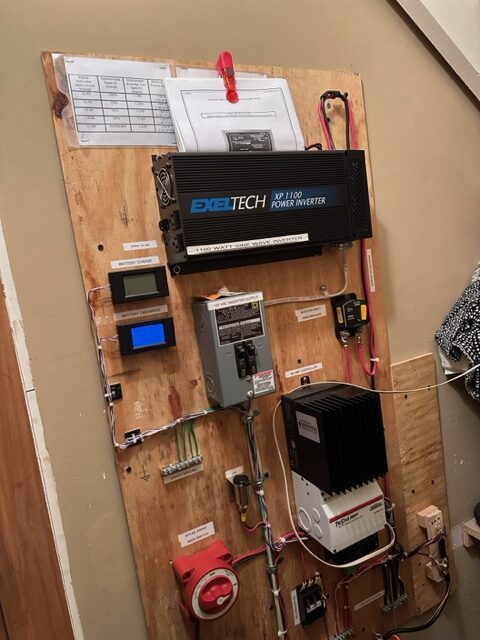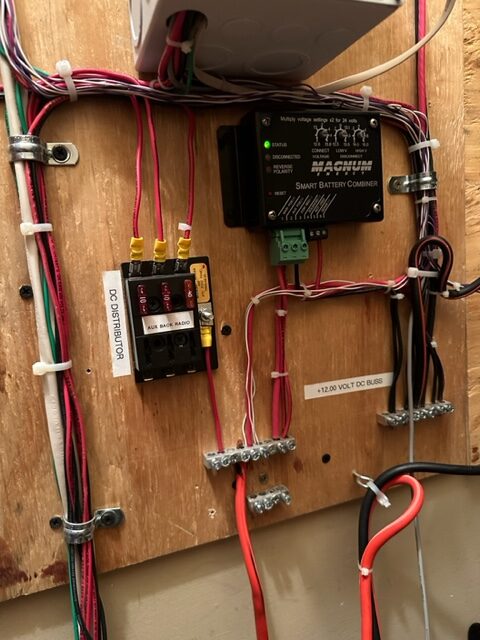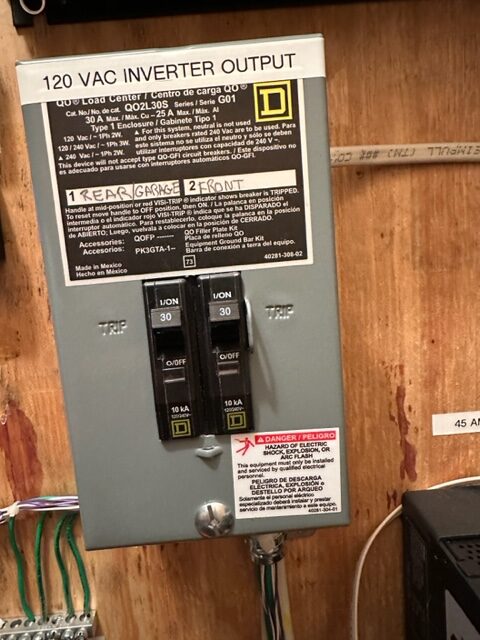Wish list.
Most off grid hams are off grid only for portable operations. Many of them would like a larger, permanent home system but don’t know where to start or what such a project involves. If having an off grid home solar power system has been a longtime wish, this article is for you! We’ll go over the planning process and important considerations for implementing your system.
This article assumes you are building your own solar plant from the ground up (not a “box system” or similar off the shelf product).
Physical layout.
The first step is to survey your solar power site. Where is the most favorable place for your solar panels? Simply having a lot of sun does not make it the “best” spot. It also has to be large enough to fit all the panels you plan to deploy.
Also consider how hard it will be to install or remove panels. Rooftops are a popular location, but do you have the means to haul the panels up there and secure them? Do you plan on replacing your roof in the next few years? If so, then it may not be worthwhile to do all that work just to undo it soon. Factor in seasonal changes. A spot that has great sun in one season may be totally useless in another.
Secondly, where will you house your, controller, batteries, and other supporting hardware? Ideally it would be an indoor, climate-controlled environment that has easy access for maintenance but will not present a safety hazard to kids, pets, and others. One caveat to follow: Your system will take up more space than you think! Allow for airflow/cooling and future changes. I have all my batteries, controller, and inverter in a closet under a stairway.

Components mounted on plywood, which is then mounted to the wall. If needed, I can remove the entire system as one module without having to disconnect every individual component. OFF GRID HAM ORIGINAL PHOTO ©2023
Lastly, where will your solar equipment be in relation to the devices it will be powering? If you are running a strictly-DC system (no inverter), then you’ll want to keep the cable runs short since copper wire is very inefficient at passing DC current over long distances. Use an on line copper wire loss calculator to determine how large your wire should be for your application.
Jumping in!
Once you’ve figured out the logistics of where all your off grid power gear will be, it’s time to start wiring it up, right? Well, actually, no. The second planning stage is to determine how the various components will relate to each other.
Most off gridders go with a wall mounted configuration. Others keep their gear in a trunk or cabinet. It does not really matter as long as the equipment is securely mounted to something. For the purpose of our discussion, we’ll go with a wall mount format.
It’s a bad idea to mount your system directly to a wall. Not only does this force you to drill a lot of holes in the wall, it looks bad and is simply not a good foundation for your system. Likewise, if you change anything later, you’ll have a wall with unused holes.
I suggest mounting your components on a sheet of plywood, then mount the plywood to the wall. If you ever want to remove your system, it will come out in one piece without the need to disconnect every single individual component. Appearance does matter! Have enough pride in your work to make it look neat and well crafted.
Mapping it out.
One of the big benefits of mounting your components on plywood is that you can experiment and try different orientations before committing to mounting them. Lay the plywood flat on a table. Arrange the controller, inverter, switches, and everything else on the plywood, but do not secure them just yet. This is just a dry run. Look at how the devices relate to one another: Wire runs, air ventilation, etc. You may have to experiment with different combinations until you hit on one that makes sense.
Once you’ve made a final decision on how you want your components arranged, go ahead and secure them down. After that, the fun part begins: Wire it up! Secure the wires neatly to the plywood and make only ninety degree turns. Running wires at angles all over the board will create a messy looking “spider web”. Cut wires to exact size; do not leave sags or loops. Make sure your components are level and square.

Components are level and square. Wiring is neat, with right angles and no “spider webs”. OFF GRID HAM ORIGINAL PHOTO ©2023
Doing all this while the board is laying flat will save a lot of hassle. If you’ve ever tried to hold a device on a vertical surface while turning a mounting screw at the same time, you understand where I’m coming from.
Solar panel strategy.
Of course we have to deal with the other end of the system: The solar panels. Some hams simply lean them against a building or a fence. Others will build their own frames for ground installations.
Neither of these options are elegant, but they are acceptable as long as the panels cannot easily be kicked around by the wind. If you are simply leaning them against a support, at the very least secure the panels to a stake in the ground.
Roof mounts will require a little more thought and care. You’re fighting gravity, after all. Commercially made roof mount hardware is the safest and most foolproof. If you make your own roof mount, make sure it is very secure. On my system, I elected to bolt stainless steel hinges to one edge of the panel, then attach the hinges to a block of wood bolted into the roof. This allows me to pitch the panels up in the winter to get a better angle to the sun.
Safety, building codes, insurance, and other important considerations.
A common concern of hams looking to build their own home solar power system is about code requirements, inspections, and permits. In the USA, codes can vary considerably between localities. The foundation all these codes are built on is the National Fire Protection Association Code 70, or NFPA-70. This document is also known as the National Electrical Code (NEC).
Local jurisdictions can and often do implement codes that are stricter than the NEC. The good news is that in most cases, solar power systems that are not connected to the grid in are exempt from permits and inspections. It’s important to stress that this exemption is a general rule. Your locality may have no such loophole. Do a little homework before you commit a lot of time and money to your project. A simple phone call to your local code enforcement office may save you a world of hassle.

120 VAC outlets are wired separately from commercial service and are fed from a separate breaker panel. OFF GRID HAM ORIGINAL PHOTO ©2023
For my installation, I wired 120V AC outlets throughout my house back to my inverter. These outlets have separate wiring and are not physically connected to the commercial power grid in any way. This is how I was able to construct my system without the need for inspections or permits. If and when I decide to sell my house, I can easily remove my entire solar power system, including the AC outlets, without disturbing any commercially-energized wiring.
Insurance is another issue. Speaking in generalities, you are probably covered in some form under your homeowner’s policy for damage or loss related to your solar power equipment. Of course the caveat is the details are specific to your contracted coverage. As before, a simple phone call may save you a lot of hurt later.
Be cagey, don’t tip your hand.
I don’t want to sound like a paranoid tinfoil hat type, but I do have a solid distrust of government. Insurance companies rank at about the same level. When speaking with these people, disclose as little information as needed to get your questions answered. Do not volunteer anything that is not pertinent to why you are contacting them.
Along those lines, be very thoughtful about to whom you disclose details about your system. Building your own solar plant is a proud accomplishment and it’s totally understandable if you want to brag and show it off. Have some good sense and operational security. Solar power is now mainstream; having panels on your roof does not particularly attract attention. Indiscriminately blabbing to the neighbors, local hams, and others may bring you unwanted attention when SHTF.
Resources.
This article goes into detail about NFPA-70 (NEC)
Here is a good discussion about operational security (OPSEC) for radio amateurs.
Check out this handy copper wire loss calculator that will help you determine the proper size wire for your application.
Hey Chris – thanks for keeping Off Grid Ham healthy, and for another good article.
We’re fortunate to have an owner-built offgrid home (blood,sweat, & tears) in Washington State.
Building inspections are done at the county level, electrical by state inspectors.
We went through the permit/inspection process and the electrical inspector was VERY helpful (and patient).
best, Rick
I’m glad it worked out for you, Rick. Thanks for the support.
Thank you Chris. I am mentaly working out a mobile solar station. This helps.
I’m glad to help. Good luck with your project.
Nice article, Chris 🙂
As Chris already knows I’m in the process of putting together a whole house solar power system, 13 KW load capacity, 240V split phase (eventually) and currently with 15 KWh of LiFePo batteries that will probably be expanded to 30 KWh. It’s been an interesting experience. I spent a good two months sketching out ideas, looking at equipment, etc. and quickly came to the conclusion that no matter what hardware you buy you’re going to run into problems that range from minor to significant. But if you’re persistent, patient and technologically savvy it can be done. It ain’t gonna be cheap, though.
One word of advice. Be very, very wary of “bargains” on solar equipment. Generally speaking you get what you pay for. Safety equipment like DC circuit breakers, fuses, etc. should be sourced from local electrical suppliers, NOT from alphabet soup companies off Amazon.
I just started to put things together and it has been fun, fascinating and frustrating all at the same time. I’ll have details up on my blog later once I get everything installed and the bugs worked out.
I’ve been following your story for a while now, and it’s great to see things coming together. It looks like you’re going to have a busy summer. Good luck, and thanks for being so supportive.
I cannot afford the Tesla Battery Bank, and I do like having software that can sell to grid for me when needed too.
Sure, I am ready to lurk and learn about wherever you go with this new venture.
AND I could always build an abbreviated version (on wheels) to do remotes with / for ham use in the field.
Pete B, W6LAW
====
Portable solar is very doable; I even have an article about it here on OGH.
Keep in mind that if you sell back to the power company you are by default not “off grid”. There’s nothing wrong with that, but for sure you will need permits and inspections. Do your due diligence and you should be fine.
Pete, I wouldn’t go with a Tesla system in any case, not just because of the fact that the prices are outrageous. From what I’ve heard Tesla uses standard LI batteries, not LiFePo. If that’s the case the batteries are only good for a few hundred charge cycles, and they are subject to the same “thermal runaway” (i.e. they blow up and burn like blow torches) problems. There were statements that they were going to switch battery chemistry to the safer LiFePo but I haven’t seen any actual confirmation of that. I wouldn’t go with the brand name equipment like Tesla or Generac because then you’re tied into a system that only works with that company’s equipment.